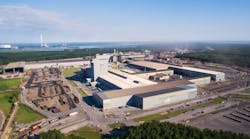Circular Steel: What It Is, How It’s Made and Its Role in Reducing Emissions
Greenhouse-gas emissions have been a point of focus and concern for industrial leaders for at least a decade.
The latest challenge is the increasing urgency, driven by climate change and escalating regulatory and public pressure, of disclosing and mitigating Scope 3 emissions that come from an organization’s supply chain.
Stakes are high, and the challenge is not easily met. Scope 3 emissions, as an EY report points out, not only have the biggest impact on a company’s footprint—contributing 75% of emissions on average—but are the most difficult to track because the company is further removed from the data and decision-making.
Compounding the problem in many industrial sectors is the outsized role that basic materials such as steel and concrete play in Scope 3 calculations. The steel industry accounted for between 7% and 9% of global CO2 emissions in 2020, and steel production results in a global average of 1.91 metric tons of CO2 emitted per metric ton of steel cast, according to the World Steel Association (worldsteel).
But there is good news as well. The urgency of reducing emissions associated with basic materials has led to widespread innovation. In fact, steel has emerged as a central element of Scope 3 emissions reductions. And a shift to low-emission recycled steel – “circular steel” – can have a significant positive impact on Scope 3 emissions.
Savvy industry leaders can take advantage of circular steel and – via product design and end-of-life planning – link it to circularity. To take full advantage, it helps to know that:
There are two ways to make steel. The traditional extractive method – extracting iron ore from the earth via mining, then refining it into pig iron in a coal-fired blast furnace and later into steel in a basic oxygen furnace – is environmentally damaging and carbon intensive due to the impact of extraction and the use of the blast furnace. The world average carbon output for extractive steelmaking is 2.33 metric tons of CO2 per ton of steel, according to worldsteel. The other method – circular steelmaking – uses recycled steel scrap as its primary feedstock, limiting the need to extract primary steelmaking materials from the earth. Instead of a blast furnace, it relies on an electric arc furnace, which consumes much less energy and produces less CO2 emissions. The average emissions output from this process has been measured at 0.77 metric tons of C02 per ton of steel – approximately 1/3 the global average and less than 1/3 of the traditional extractive process.
Only circular steel made in an electric arc furnace is truly green. The Global Steel Climate Councils’ Steel Climate Standard calls for both recycled steel and the use of electric arc furnaces. The competing Responsible Steel Standard uses a sliding scale that allows for the continued use of blast furnaces. Only the GSCC ‘s single standard allows industry leaders to know and act on the total amount of embodied carbon emissions in the steel they buy.
Other methods of producing circular green steel, such as hydrogen reduction, may emerge, but they are not yet practical. In theory, it is possible to replace natural gas for green steel production with blue hydrogen (produced from natural gas via steam reforming with the addition of carbon capture) or green hydrogen (extracted by using renewables instead of fossil fuels). But the economics don’t make sense today. Affordable green energy is already available in the form of wind, solar, small-scale nuclear or geothermal power generation. Hydrogen may someday join the list – but not yet.
Scrap steel for recycling is in good supply – but more markets in more global regions will help. Recently there have been dire predictions, including by BCG, of scrap steel shortages. There is some truth to this – demand is high and may create supply imbalances – but the situation is not as grave as it seems. In the U.S., according to the American Iron and Steel Institute, 70 million tons of domestic scrap steel are used in new steel production. That is a healthy supply. Globally, the answer to possible shortfalls is to create more markets, as happened in the U.S. over the past 60 years. In Asia, several countries, including China, India, Japan and South Korea are major steel industry players and demand is high. China and India in particular are major scrap steel importers. Expanded scrap steel markets in Asia can balance supply and demand.
Circular steel is not just a material to be used but a life-cycle management opportunity. While it’s true that replacing extractive steel with circular steel leads to immediate Scope 3 improvement, the bigger opportunity is to take even more control over Scope 3 by fully embracing circularity. That means building end-of-life recycling into new products via design and by planning for end-of-life logistics. As recycling expands to include other metals such as copper, planning for full circularity becomes even more critical.
Of course, the implications of circular steel, its Scope 3 impact and the resulting strategic considerations vary by industry. Here are just three examples.
Automotive – For an industry that is a major steel consumer and one that must grapple with complex Scope 1, 2 and 3 challenges, the benefits of circular green steel are clear. But the industry can also be a major contributor to circularity and the end-of-life stage, and not just via scrap steel. EV batteries will increasingly be a focus of recyclers. Domestic capability is needed to keep those EVs – their steel, batteries and extensive customer data – from being exported. Investment and industry advocacy will be needed to achieve this.
Construction – There is of course high demand for green steel to support the global building boom that is driving urbanization. But infrastructure presents another opportunity in which circularity can come fully into play. Aging infrastructure – bridges and structures due for replacement – can and should become a ready source of scrap to produce green steel for new infrastructure projects.
Energy – Steel is an essential component of a new clean energy future and circular steel is the best way to ensure that a clean energy transition is not compromised by high-embodied carbon materials. But here again, the bigger opportunity is in end-of-life circularity, in this case recycling steel from oil facilities and pipelines and from coal plants that are going out of service. Many of these facilities are being repurposed into new clean-energy facilities such as wind, solar and new nuclear – taking advantage of existing transmission infrastructure. The industry can take the lead in this application of circularity and provide the scrap steel that helps make the transition to new, cleaner energy sources.
Bottom line – every challenge can become an opportunity. For the steel industry, that means the shift to circular steel and a new role as part of the climate solution, not the problem. For industry, it’s the ability to reduce Scope 3 emissions by choosing green steel, and to commit to circularity – including steel – to slash emissions still more.




